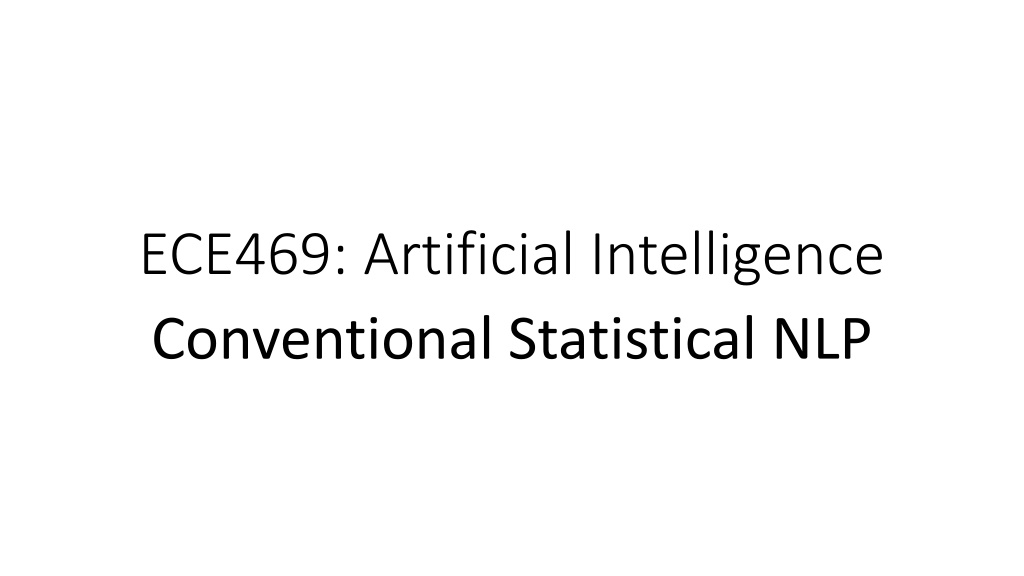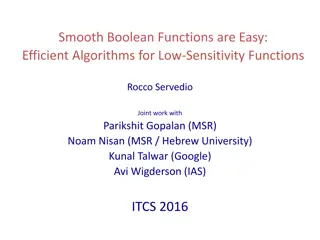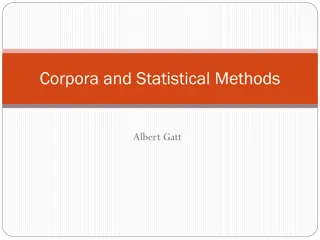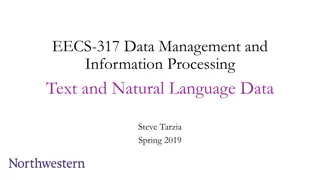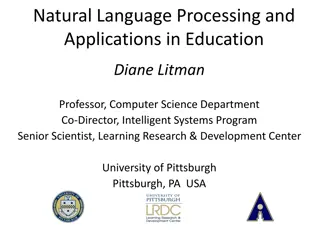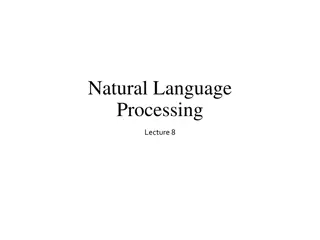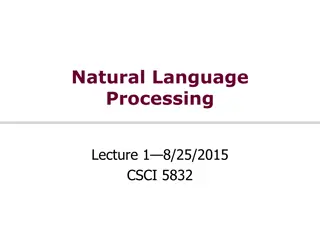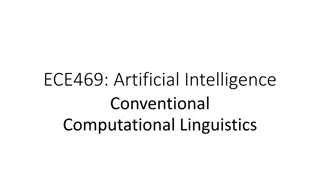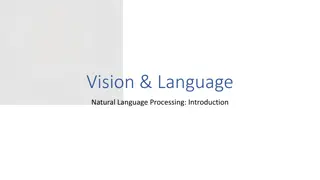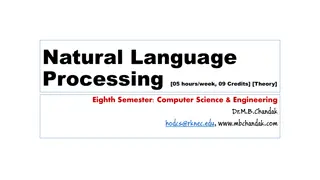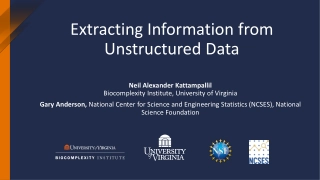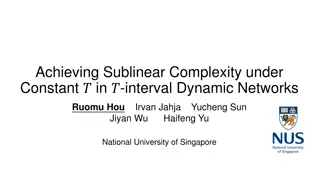Unveiling the Complexity of Natural Language Processing
Exploring the intricate nature of Natural Language Processing, this text delves into the historical significance of conventional methods, the integration of deep learning, and the challenges in understanding human languages, as highlighted by Jurafsky and Martin's analysis.
Download Presentation

Please find below an Image/Link to download the presentation.
The content on the website is provided AS IS for your information and personal use only. It may not be sold, licensed, or shared on other websites without obtaining consent from the author. Download presentation by click this link. If you encounter any issues during the download, it is possible that the publisher has removed the file from their server.
E N D
Presentation Transcript
ECE469: Artificial Intelligence Conventional Statistical NLP
Natural Language Processing Natural language processing (NLP) is a subfield of artificial intelligence (AI) that deals with the processing of text specified using natural languages NLP was my field as a graduate student Natural languages are languages that are spoken by (or written by or otherwise used by) people; e.g., English, French, Japanese, etc. This is as opposed to formal languages, such as first-order logic or programming languages In this course, our unit on NLP is divided into three topics; I am calling them: "Conventional Statistical Natural Language Processing" This will cover statistical NLP approaches that dominated the field until around 2013 "Conventional Computational Linguistics" This covers natural languages, in general, and approaches to processing natural languages that consider linguistics "Deep Learning and NLP" This covers modern approaches to NLP Some of the content of this topic is based on material from "Speech and Language Processing" by Jurafsky and Martin (J&M); the 3rdedition is in progress, and updates are freely posted online
Why Cover Old Stuff? Some modern sources on NLP pay very little attention to conventional methods for NLP (i.e., those that predated deep learning) I personally consider this a mistake for at least three reasons: Conventional methods are still useful for certain tasks (e.g., information retrieval) Aspects of conventional methods are sometimes used as precursors to deep learning methods (e.g., tokenization) In order to appreciate how deep learning is applied to NLP tasks, it is important to understand how these tasks used to be performed
Why is NLP hard? Humans have an uncanny ability to learn a language (at least when they are very young) However, we are (in my opinion) very far from having computers that appear to understand (or perhaps actually understand) human languages The Jurafsky and Martin textbook gives five possible interpretations of the ambiguous sentence, "I made her duck" (although I would say that at least one of them is debatable) Jurafsky and Martin point out: The words "duck" and "her" are ambiguous in their part-of-speech; "duck" can be a verb or noun, "her" can be a dative pronoun or possessive pronoun The word "make" is semantically ambiguous; it can mean "create" or "cook" The word "make" is also syntactically ambiguous It can be transitive, taking a single object ("her duck") It can be ditransitive, taking two objects (if the sentence means that I changed her into a duck, but I think this would be an example of poor grammar) It can take a direct object and a verb (if I forced her to duck her head) If the sentence was spoken, there would also be ambiguity related to words that sound the same; e.g., "eye" or "maid"
Machine Learning for NLP Using machine learning for NLP is, in some sense, simpler, and it is more robust than processing and representing natural language text using rules However, with conventional machine learning, there are several initial phases that a system must apply when processing a text document Often, sentence segmentation first divides a document into individual sentences Then, tokenization splits each sentence into tokens (typically representing words) None of this is trivial, and no phase is typically error-free For example, sentences typically end with certain punctuation, such as periods; but periods are also used for abbreviations and acronyms (which can occur at the end or middle of a sentence) It is also not clear what should count as a word For example, stemming or lemmatization can be applied to map different forms of a word to the same token Some systems split contractions or possessive words ending in 's to separate tokens For some languages (e.g., polysynthetic languages), it may be important to apply more complex morphological parsing to split a word into morphemes A morpheme is the smallest part of a word that has semantic meaning
Language Models We can define a language to be a set of allowable strings (e.g., all allowable sequences of words, characters, or more general tokens) We ll cover attempts to formalize the syntax of natural languages (focusing on English) using grammars in our next topic The statistical NLP approach deals with language models A language model assigns a probability distribution to all possible string sequences Language models can be used to predict the likelihood of a particular sequence of words, characters, or tokens A language model can also be used for natural language generation (NLG) A language model is often a piece of a more general system, where the model is used to help produce output that is more likely to be fluent
N-gram Models An n-gram is a sequence of n tokens; common n-grams include 1-grams (unigrams), 2-grams (bigrams) and 3-grams (trigrams) In conventional NLP, the tokens are typically words, but they can be characters, subwords, embeddings, etc. Character-level n-grams models have sometimes been used for language identification An n-gram model computes the probability distribution for each possible final token of an n-gram given the previous n-1 tokens As n increases, we are taking into account more context, but the data becomes sparser, so estimations are less accurate A word-based N-gram language model approximates that P ?1:? = ?=1 ?=1 P(??|?? ?+1:? 1) For a bigram language model, this becomes P ?1:? = ?=1 Note that this is an example of a Markov assumption Word-based n-gram models are often part of a larger system, to help produce more fluent output Some applications that conventionally relied on word-based n-gram models include speech recognition, machine translation, spelling correction, grammatical error correction, and augmentative communication ? P ??|?1:? 1 = ? ? P(??|?? 1)
Estimating N-gram Probabilities To learn the probabilities related to an n-gram model, we train it on a corpus (serving as a training set) of the language being modeled; note that this is an example of unsupervised machine learning It is important that the training data reflects the nature of the data that we are likely to see later The simplest way to estimate n-gram probabilities is to use maximum likelihood estimation (as we covered during our unit on Bayesian learning); for example, for bigrams, this gives us: ? ???? 1 = ?(?? 1) Note that at the start of the sequence, to apply a bigram model when there is no previous word, we may need to fall back to a unigram probability estimate In practice, this may not be necessary if we are including special start-of-sentence markers One problem with ML estimation is that N-grams which have never been seen will be assigned the probability of zero This can be avoided using smoothing techniques; proper smoothing was often very important for conventional, statistical NLP methods Another problem relates to out-of-vocabulary (OOV) words One possible solution is to replace very infrequent words in the training set with a special token, <UNK> ?(?? 1??) ??(?? 1?)=?(?? 1??)
Evaluating Language Models One way to evaluate a language model is by applying it to a held-out test set and estimating the probability of the text according to the language model This is an example of intrinsic evaluation A better language model is one that assigns a higher probability to the test set However, multiplying a lot of probabilities together is likely to zero-out the computation due to the finite precision of floating-point variables Therefore, it is more common to add log probabilities, which avoids this issue and is also more efficient Alternatively, a metric known as perplexity, which is related to the sum of the log probabilities, is often used Sequences with higher probabilities have lower perplexities Alternatively, we can evaluate a language model by embedding it in a more general application and seeing how it affects performance This is an example of extrinsic evaluation This may be a more important sort of metric, but it can require more time and effort
Parts of Speech Parts of speech (POS) are categories of words; these are also known as word classes, lexical tags, and syntactic categories Four major open classes of POS occur in languages of the world; they are: nouns, verbs, adjectives, and adverbs; not every language has all four There are also many closed classes of POS; for example: prepositions, particles, determiners, conjunctions, pronouns, auxiliary verbs, numerals, etc. Modern lists of parts of speech (or tagsets) for English include many additional POS tags; e.g., there are 45 for the Penn Treebank, 87 for the Brown corpus, and 146 for the C7 tagset Linguists typically define POS based on syntactic and morphological function A noun, for example may often describe a person, place, or thing, but not always; nouns also include abstractions (e.g., "bandwidth", "relationship"), verb-like terms (e.g., "pacing"), etc. What defines the noun category for English are things like: Its ability to occur with determiners (e.g., "a goat", "its bandwidth", "Plato's Republic") Its ability to take possessives (e.g., "IBM's annual revenue") For most nouns, its ability to occur in the plural form (e.g., "goats", "abaci")
POS Tagging Part-of-speech tagging (a.k.a. POS tagging or just tagging) is the automatic assignment of POS to words Tagging a word with its POS can tell us about how a word is pronounced (e.g., "content" as a noun or an adjective); this can be useful for a text-to-speech system POS can also be useful for several other NLP applications, including parsing, named entity recognition, and coreference resolution The earliest POS taggers used manual rules, but later, machine learning approaches dominated Conventionally, hidden Markov models (HMMs) were often used Another conventional approach involved maximum entropy Markov models (MEMMs) These days, deep learning approaches can do better, but not by much According to the Jurafsky and Martin textbook, all these ML approaches are capable of achieving around 97% accuracy on standard datasets
HMMs Revisited We have learned that HMMs can be represented as dynamic Bayesian networks: The Xs represent hidden states that are not seen (typically, these are what we are trying to predict) The Es represent evidence variables which are observed In many sources, an E0would be included; but we can view the X0as a start-of-sequence marker that does not have an associated evidence variable The links between Xs represent transitions between hidden states, and there are associated transition probabilities The links from Xs to Es have associated emission probabilities (a.k.a. observation likelihoods)
HMMs for POS Tagging When applied to POS tagging, the hidden states represent parts of speech, and the evidence variables represent observed words The parameters of the HMM for POS tagging can be easily learned from a treebank A treebank is a corpus in which words have been labeled with their POS, and sentences have been manually parsed Maximum likelihood learning can be used to learn the parameters of an HMM for POS tagging The transition probabilities can be estimated as the frequency of seeing each possible POS after another POS (or as the first POS) The emission probabilities can be estimated as the frequency of seeing every possible word in the language given the current POS Smoothing techniques can be applied, but it isn t really crucial for POS tagging Once the parameters have been learned, the Viterbi algorithm (covered during our topic on HMMs) can be used to predict the most likely POS for a given sentence
Information Retrieval Information Retrieval (IR) refers to the task of finding documents from a collection or corpus that are relevant to a user's query What constitutes a document varies form system to system (e.g., a web page, e-mails, news documents, single paragraphs or sentences, etc.) Note that IR can also involve non-textual documents, including videos, images, music files, etc., but we will be focusing on textual documents The query might be expressed in natural language or some formal query language Early IR systems used a Boolean keyword model (i.e., allowing AND and OR) for queries This had several drawbacks; for example, if "information AND retrieval AND models AND optimization" returns an empty result set, what do you do next? IR systems also differ in how results are presented; one common approach is to display a ranked list of documents There was a time when probabilistic IR methods (e.g., na ve Bayes) were used in practice; however, other another method came to dominate conventional NLP for IR
Vector Space Models The dominant approach for IR in conventional NLP uses a vector space model to represent documents Each document is represented as a vector, and each dimension represents a word or term from the language This is an example of a bag-of-words approach; this basically means that words, or more generally terms, are statistical tokens, and there is no attention payed to syntax or semantics Simple approaches might use 1s and 0s to indicate words that are present or not present in a document; in practice, you can get much better results by weighting the words The most common conventional method in the NLP literature uses TF*IDF word weights The term frequency (TF) of a word is just the number of times that the word occurs in a document (or query) Inverse document frequency (IDF) is a measure of a word's rarity across a corpus; rare words tend to be more specific IDF can be computed as follows (some sources define it a bit differently): IDF w = log# of documents in collection # of documents containing w Relevant documents are then selected by finding the documents whose vectors are "closest" to the query (using a distance metric or, more typically, a similarity metric such as cosine) Since you don't want to favor large documents (which are likely to have larger TF values and contain more of the query words by chance), you typically normalize the document vectors
Implementing IR Systems We can also consider the entire collection to be represented as a sparse matrix of weights, where wi,jrepresents the weight of word i in document j This is known as a term-document matrix Each column represents a document in the collection and each row represents a term in the vocabulary of the document's language In practice, we do not store the entire matrix; rather, for each term, we store an inverted index For IR, an inverted index efficiently maps each term (e.g., using a hash table) to a list of documents in which the term appears The inverted index can also include positions and/or term weights (such as TF*IDF) Including positions is important if you want the user to be able to search for exact phrases Other issues related to IR include how to tokenize queries and documents, case sensitivity, whether to apply stemming, whether to prune stop words, whether to consider metadata, etc. When presenting results of an IR system, you might want to take utility into account in addition to relevance; e.g., you might not want to list very similar documents
Evaluating IR Systems IR systems can be evaluated using the precision, recall, and F1 metrics We generally wouldn't want to use overall accuracy to evaluate IR systems because a simple system that says nothing is relevant might achieve a very high score Consider a confusion matrix (a.k.a. contingency table) representing how many relevant and non-relevant documents were and were not retrieved: Relevant Not Relevant Retrieved A B Not Retrieved C D We can define: Precision = A / (A + B); of the documents that were retrieved by the system, this is the fraction of them that are relevant to the user s query Recall = A / (A + C); of those documents in the collection that are relevant to the query, this is the fraction of them that were retrieved by the system F1 = (2 * Precision * Recall) / (Precision + Recall); this combines precision and recall into a single metric, in between precision and recall, closer to the lower of the two In practice, the set of relevant documents is not always known, and other metrics may have to be used instead (we will not discuss these in this course)
Presenting Results of Web Searches When presenting the results of web searches, systems have additional information to work with; we will briefly discuss two algorithms that treat the web as a directed graph The Hyperlinked-Induced Topic Search (HITS) algorithm involves authorities and hubs Given a query, HITS first finds an initial set of web pages that are relevant to the query Using this set, an iterative approach determines authorities (pages that have a lot of incoming links from other good pages) and hubs (pages that point to a lot of authorities) Google's PageRank algorithm also rates pages based on links, but their algorithm is not query- dependent, and it is therefore more efficient PageRank uses the following formula: ?? ? ? Here, PR(p) is the PageRank of page p, N is the total number of pages in the corpus, iniare the pages that link to p, and c(ini) is the count of the out-links on ini; d is a damping factor To explain this, the AI textbook (3rdedition) asks us to imagine a web surfer starting at a random page With probability d, he clicks on one of the links on the page arbitrarily; with probability 1-d, he gets bored and moves to any random page on the web PR(p) is related to the probability that the surfer will be at page p at any point in time Since PageRank uses a recursive formula, computing it involves an iterative procedure; the algorithm starts assigning PR(p) = 1 to every page, and it iterates until convergence =1 ? ??(???) ?(???) + ? ?
Text Categorization Text Categorization (TC), a.k.a. text classification, is the automatic labeling of text documents (or documents with associated text) into one or more predefined categories or classes As with other ML categorization methods, text categorization can deal with independent, Boolean categories, or it can deal with mutually exclusive and exhaustive categories Some applications of text categorization include: Classification of e-mail as spam or not spam (a.k.a. ham), i.e., spam filtering Classification of news into topical sections (e.g., Columbia NewsBlaster, Google News) Websites as pornography or not pornography Reviews as positive or negative (a type of sentiment classification) Automatic grading of essays (used by ETS) An interesting early application of text categorization was authorship attribution Mostellar and Wallace (1964) examined a subset of the Federalist Papers There was a historical dispute about whether the author was James Madison or Alexander Hamilton Using techniques that were quite different than modern techniques (involving words such as "of" and "upon"), they definitively concluded that Madison was the author
Some General TC Implementation Details Conventional TC systems typically employ bag-of-words approaches, as do IR systems These approaches work well for some, but not all, of the applications listed above Most conventional TC systems use single words (unigrams) as terms Several TC methods use TF*IDF weights for document vectors; some also use TF*IDF weights for category vectors As with IR systems, other implementation details that must be decided include tokenization, case sensitivity, stemming, stop words, etc. A training set for TC consists of manually labeled documents If categories are Boolean, we need positive and negative examples of each category If categories are mutually exclusive and exhaustive, we need a significant number of examples of each category Tuning based on a validation set and evaluation using a test set are performed using standard machine learning techniques Many ML techniques can be applied to TC; we will not discuss the details in this class
Evaluating a TC System To evaluate a TC system, overall accuracy can be a reasonable metric if both of the following are true: The categories are mutually exclusive and exhaustive, and Each category occurs with a significant frequency Otherwise, we can measure the precision, recall, and F1 for each category Micro-averaging or macro-averaging can be used to obtain a metric for an entire dataset Recall that the no free lunch theorem tells us that no machine learning method will work well for all possible tasks It should therefore not be too surprising that different systems tend to work well for different types of TC tasks This probably depends, at least in part, on the properties of the categories and the of the data that we are dealing with
Properties of Categories There are many factors to consider that can affect which methods perform the best for a particular text categorization task First, we will consider some properties of the categories (most of these are not specific to TC): Are they mutually exclusive and exhaustive or independent, binary categories? Are they general or specific categories? Related to the last question, do the documents within a category vary a lot, or do they tend to be very similar to each other? Are they topic-based categories? Are they action oriented? Do they involve sentiment? Are they abstract? Are there many categories or few? Are some categories significantly more likely than others (i.e., do some categories contain a relatively high or low percentage of documents)?
Properties of Data Next, we will consider some properties of the data (a couple of these are specific to TC): Are the documents short or long? How big is the training set (i.e., how many documents are in it)? Is the training set likely to be very representative of the documents to which the system will be applied later? Are the training labels accurate or is there a high degree of error? (This could depend on how the training data is collected) Is there any missing data? (This is not generally an issue with TC, but it is an issue that some machine learning methods handle better than others) Is there additional metadata (text or otherwise) associated with documents? Properties of the categories and data may affect which ML, and specifically TC, methods perform well for a given task Especially when we consider the No Free Lunch theorem, we have no reason to assume that one method will perform the best for all tasks
